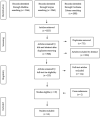Interventions to Promote Healthy Meals in Full-Service Restaurants and Canteens: A Systematic Review and Meta-Analysis
- PMID: 33919552
- PMCID: PMC8073122
- DOI: 10.3390/nu13041350
Interventions to Promote Healthy Meals in Full-Service Restaurants and Canteens: A Systematic Review and Meta-Analysis
Abstract
Out-of-home eating is increasing, but evidence about its healthiness is limited. The present systematic review and meta-analysis aimed to elucidate the effectiveness of full-service restaurant and canteen-based interventions in increasing the dietary intake, food availability, and food purchase of healthy meals. Studies from 2000-2020 were searched in Medline, Scopus, and Cochrane Library using the PRISMA checklist. A total of 35 randomized controlled trials (RCTs) and 6 non-RCTs were included in the systematic review and analyzed by outcome, intervention strategies, and settings (school, community, workplace). The meta-analysis included 16 RCTs (excluding non-RCTs for higher quality). For dietary intake, the included RCTs increased healthy foods (+0.20 servings/day; 0.12 to 0.29; p < 0.001) and decreased fat intake (-9.90 g/day; -12.61 to -7.19; p < 0.001), favoring the intervention group. For food availability, intervention schools reduced the risk of offering unhealthy menu items by 47% (RR 0.53; 0.34 to 0.85; p = 0.008). For food purchases, a systematic review showed that interventions could be partially effective in improving healthy foods. Lastly, restaurant- and canteen-based interventions improved the dietary intake of healthy foods, reduced fat intake, and increased the availability of healthy menus, mainly in schools. Higher-quality RCTs are needed to strengthen the results. Moreover, from our results, intervention strategy recommendations are provided.
Keywords: family; food behavior; food-service; menu choice; out-of-home eating; restaurant; restaurant-based interventions.
Conflict of interest statement
The authors declare no conflict of interest. The funders had no role in the design of the study; in the collection, analyses, or interpretation of data; in the writing of the manuscript, or in the decision to publish the results.
Figures




Similar articles
-
Effects of a randomized intervention promoting healthy children's meals on children's ordering and dietary intake in a quick-service restaurant.Physiol Behav. 2018 Aug 1;192:109-117. doi: 10.1016/j.physbeh.2018.01.022. Epub 2018 Feb 1. Physiol Behav. 2018. PMID: 29397146 Clinical Trial.
-
Using fundraising incentives and point-of-purchase nutrition promotion to improve food choices among school families in restaurants: a pilot and feasibility study.Public Health Nutr. 2020 Aug;23(11):2006-2015. doi: 10.1017/S1368980019004609. Epub 2020 Apr 15. Public Health Nutr. 2020. PMID: 32290880 Free PMC article. Clinical Trial.
-
How do you choose your meal when you dine out? A mixed methods study in consumer food-choice strategies in the restaurant context.Appetite. 2024 Dec 1;203:107683. doi: 10.1016/j.appet.2024.107683. Epub 2024 Sep 19. Appetite. 2024. PMID: 39303827
-
Healthy eating interventions conducted in small, local restaurants and hot food takeaways: a systematic review.Public Health Nutr. 2025 Jan 9;28(1):e24. doi: 10.1017/S1368980025000035. Public Health Nutr. 2025. PMID: 39783012 Free PMC article.
-
Dietary Interventions to Promote Healthy Eating among Office Workers: A Literature Review.Nutrients. 2020 Dec 7;12(12):3754. doi: 10.3390/nu12123754. Nutrients. 2020. PMID: 33297328 Free PMC article. Review.
Cited by
-
Impact of Plant-Based School Meals on Gut Bifidobacterium spp. Abundance and Health Outcomes in Schoolchildren from Bahia, Brazil.Int J Mol Sci. 2024 Dec 5;25(23):13073. doi: 10.3390/ijms252313073. Int J Mol Sci. 2024. PMID: 39684783 Free PMC article.
-
Eating contexts determine the efficacy of nutrient warning labels to promote healthy food choices.Front Nutr. 2023 Jan 6;9:1026623. doi: 10.3389/fnut.2022.1026623. eCollection 2022. Front Nutr. 2023. PMID: 36687700 Free PMC article.
-
Effects of nutritional intervention strategies in the primary prevention of overweight and obesity in school settings: systematic review and network meta-analysis.BMJ Med. 2022 Dec 23;1(1):e000346. doi: 10.1136/bmjmed-2022-000346. eCollection 2022. BMJ Med. 2022. PMID: 36936562 Free PMC article.
-
The impact of altering restaurant and menu option position on food selected from an experimental food delivery platform: a randomised controlled trial.Int J Behav Nutr Phys Act. 2023 May 19;20(1):60. doi: 10.1186/s12966-023-01456-8. Int J Behav Nutr Phys Act. 2023. PMID: 37208720 Free PMC article. Clinical Trial.
-
Development of a tool to assess the compliance of cafeteria menus with the Mediterranean Diet.BMC Nutr. 2024 Dec 18;10(1):163. doi: 10.1186/s40795-024-00975-2. BMC Nutr. 2024. PMID: 39695916 Free PMC article.
References
-
- Jia X., Liu J., Chen B., Jin D., Fu Z., Liu H., Du S., Popkin B.M., Mendez M.A. Differences in nutrient and energy contents of commonly consumed dishes prepared in restaurants v. at home in Hunan Province, China. Public Health Nutr. 2018;21:1307–1318. doi: 10.1017/S1368980017003779. - DOI - PMC - PubMed
Publication types
MeSH terms
Grants and funding
LinkOut - more resources
Full Text Sources
Other Literature Sources

